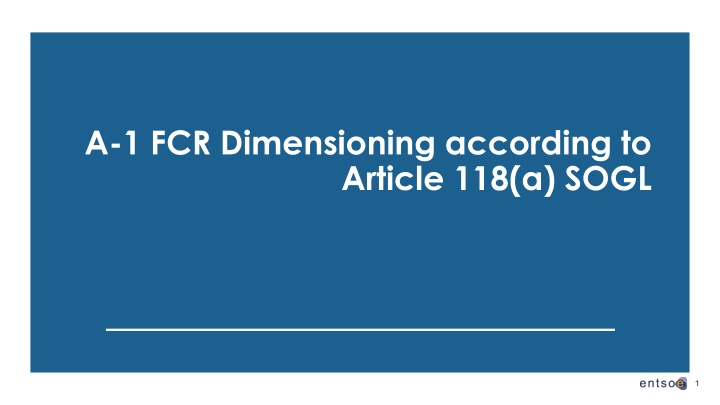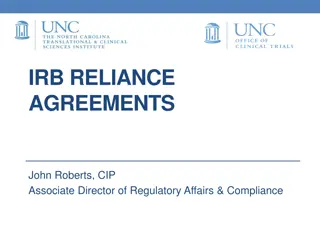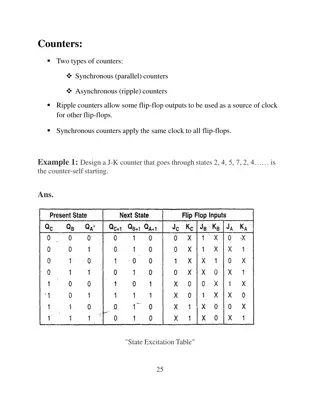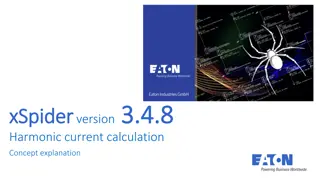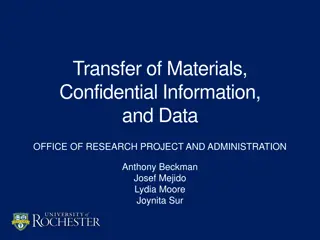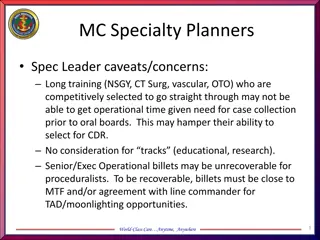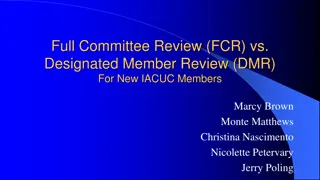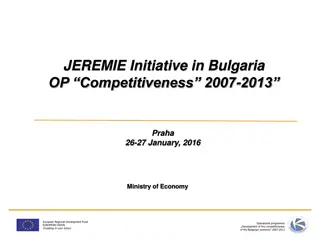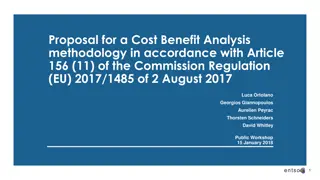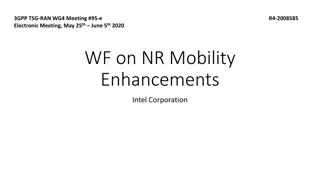FCR Dimensioning Rules Proposal for Synchronous Area Operational Agreements
Article 118 of the Synchronous Operational Agreements introduces rules for the dimensioning of Frequency Containment Reserve (FCR). The proposal requires TSOs to jointly develop guidelines for FCR dimensioning, including annual reserve capacity determination and initial obligations. Specific criteria are outlined for FCR reserve capacity, probabilistic dimensioning approaches, and allocation of obligations based on net generation and consumption. The implementation aims to ensure adequate FCR provision and maintain grid stability within Synchronous Areas.
Download Presentation

Please find below an Image/Link to download the presentation.
The content on the website is provided AS IS for your information and personal use only. It may not be sold, licensed, or shared on other websites without obtaining consent from the author.If you encounter any issues during the download, it is possible that the publisher has removed the file from their server.
You are allowed to download the files provided on this website for personal or commercial use, subject to the condition that they are used lawfully. All files are the property of their respective owners.
The content on the website is provided AS IS for your information and personal use only. It may not be sold, licensed, or shared on other websites without obtaining consent from the author.
E N D
Presentation Transcript
A-1 FCR Dimensioning according to Article 118(a) SOGL 1
Index 1 Introduction 2 FCR Dimensioning Rules proposal 3 Conclusions 4 Q&A 2
Introduction Background Article 118 (Synchronous area operational agreements) of SO GL establishes: 1. By 12 months after entry into force this Regulation, all TSOs of each synchronous area shall jointly develop a common proposal for: a) FCR dimensioning rules for FCR in accordance with Article 153. b) c) 4
Introduction Article 153 (FCR dimensioning) of SO GL establishes: 1. All TSO of each SA shall determine, at least, annually, the reserve capacity for FCR required for the SA and initial FCR obligation of each TSO in accordance with paragraph 2. 2. All TSOs of each Synchronous area shall specify dimensioning rules in the Synchronous area operational agreement in accordance with the following criteria: a) The reserve capacity for FCR required for the SA shall cover at least the referent incident b) (i) For CE SA the referent incident shall be 3.000 MW in positive and negative direction. and For CE, the results of the probabilistic dimensioning approach for FCR pursuant to point (C). c) For CE SA, all TSOs shall have the right to define a probabilistic dimensioning approach for FCR taking into account the pattern of load, generation and inertia, including synthetic inertia as well as the available means of deploy minimum inertia in real time in accordance with the methodology referred to in Article 39, with the aim of reducing the probability of insufficient FCR to below or equal to once in 20 years. 3000 MW Referent incident Result of the probabilistic dimensioning approach Optional 5
Introduction Article 153 (FCR dimensioning) of SO GL establishes: 2. All TSOs of each Synchronous area shall specify dimensioning rules in the Synchronous area operational agreement in accordance with the following criteria: d) The shares of the reserve capacity on FCR required for each TSO as initial FCR obligation shall be based on the sum of the net generation and consumption of its control area divided by the sum of the net generation and consumption of the SA over a period of one year. 6
FCR Dimensioning Rules proposal 7
FCR Dimiensioning rules proposal Article 3 (Dimensioning rules for the TSO of SA CE) The FCR dimensioning for Synchronous area Continental Europe in positive and negative direction is equal to the reference incident of 3.000 MW, according to SO GL 153 (2b.i) All TSOs in SA CE agreed after majority voting on not using right now this probabilistic approach, due to the following facts: The basic dimensioning criterion of the FCR is to withstand the reference incident. This criterion has proven to be enough to ensure the conditions for maintaining the frequency quality level and respecting the operational security requirements. A probabilistic methodology must assume starting hypothesis, which some of them are now under ongoing definition/assessment and have an influence on the results: K-factor Time period required for FCR providing units or groups with limited energy reservoirs Full activation time of automatic FRR Tripping rates of the generation plants (demanding input data, which could lead to mistakes, or even transparency issues) Patterns of load, generation and inertia (including synthetic inertia) Optional Result of the probabilistic dimensioning approach 3000 MW Referent incident 8
FCR Dimiensioning rules proposal Article 3 (Dimensioning rules for the TSO of SA CE) The shares of the reserve capacity on FCR required for each TSO ?? as initial FCR obligation for a considered calendar year ? shall be based on the following expression, according to Article 153(2d) for all TSOs in SA CE: ??.? 2+ ??.? 2 ??.? 2+ ??.? 2 ??,?= ??????????????? Every year but not later than March 31th, each TSO of the synchronous area CE shall provide to each other the data regarding the generation and consumption in its control area in the previous calendar year. ?i,? being the initial FCR obligation for TSO i for the calendar year ? ; ??????????????? being the FCR dimensioning value calculated for synchronous area CE; ??,? 2 being the electricity generated in the control area i (including the electricity production for exchange of reserves and scheduled electricity production from jointly operated units or groups) during the second last calendar year with respect to the considered year ?; ??,? 2 being the electricity consumption in the control area i during the second last calendar year with respect to the considered year ?; ??,? 2 being the total (sum of) electricity production in all control areas of the synchronous area CE during the second last calendar year with respect to the considered year ?; ??,? 2 being the total consumption in all control areas of the synchronous area CE during the second last calendar year with respect to the considered year ?. 9
Conclusions 10
Conclusions An appropriate amount of FCR available in the Synchronous Area CE is essential to stabilise the System Frequency at a stationary value after any imbalance between generation and consumption. The basic criterion used for FCR dimensioning is to withstand the Reference Incident in the Synchronous Area by containing the System Frequency within the Maximum Frequency Deviation and stabilizing the System Frequency within the Maximum Steady-State Frequency Deviation. This criterion has proven to be enough for ensuring the conditions for maintaining the frequency quality level and respecting the operational security requirement. The FCR dimensioning rules proposal respects the requirements set in Article 153(2) of the SO GL. The FCR dimensioning rules proposal responds to the objectives of SO GL to ensure the conditions for maintaining operational security and frequency quality level through the Union, and contributes to the benefit of all market participants and electricity end consumers. 11
Q&A 12
BACKUP 14
FCR dimensioning: Probabilistic approach methodology This approach takes into account the probability of FCR deployment due to the following operational situations: Forced instantaneous outages of generation modules: modelled by a probability density function, calculated by using a one-minute sequential Montecarlo simulation. Imbalances due to changes in demand, renewable generation or the market-induced imbalances: modelled by a probability density function calculated by using historical frequency deviation data. 15
FCR dimensioning: Probabilistic approach methodology The total amount of FCR required in CE is the result of the convolution of the previous described probability density functions, once a level of confidence is set (probability of insufficient FCR below or equal to once in 20 years equivalent to once occurrence in 10.512.000 minutes-). 1 10.512.000 10 8 16
